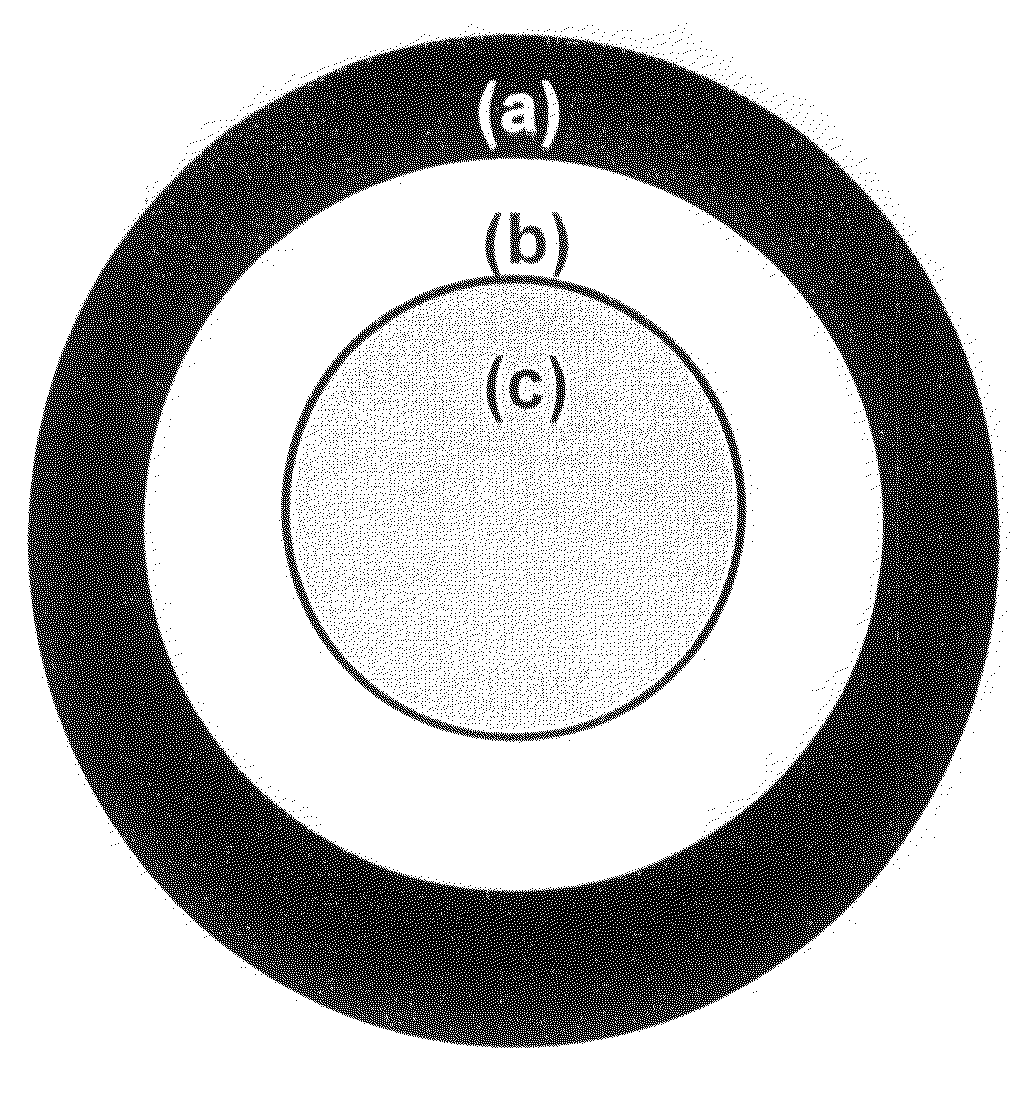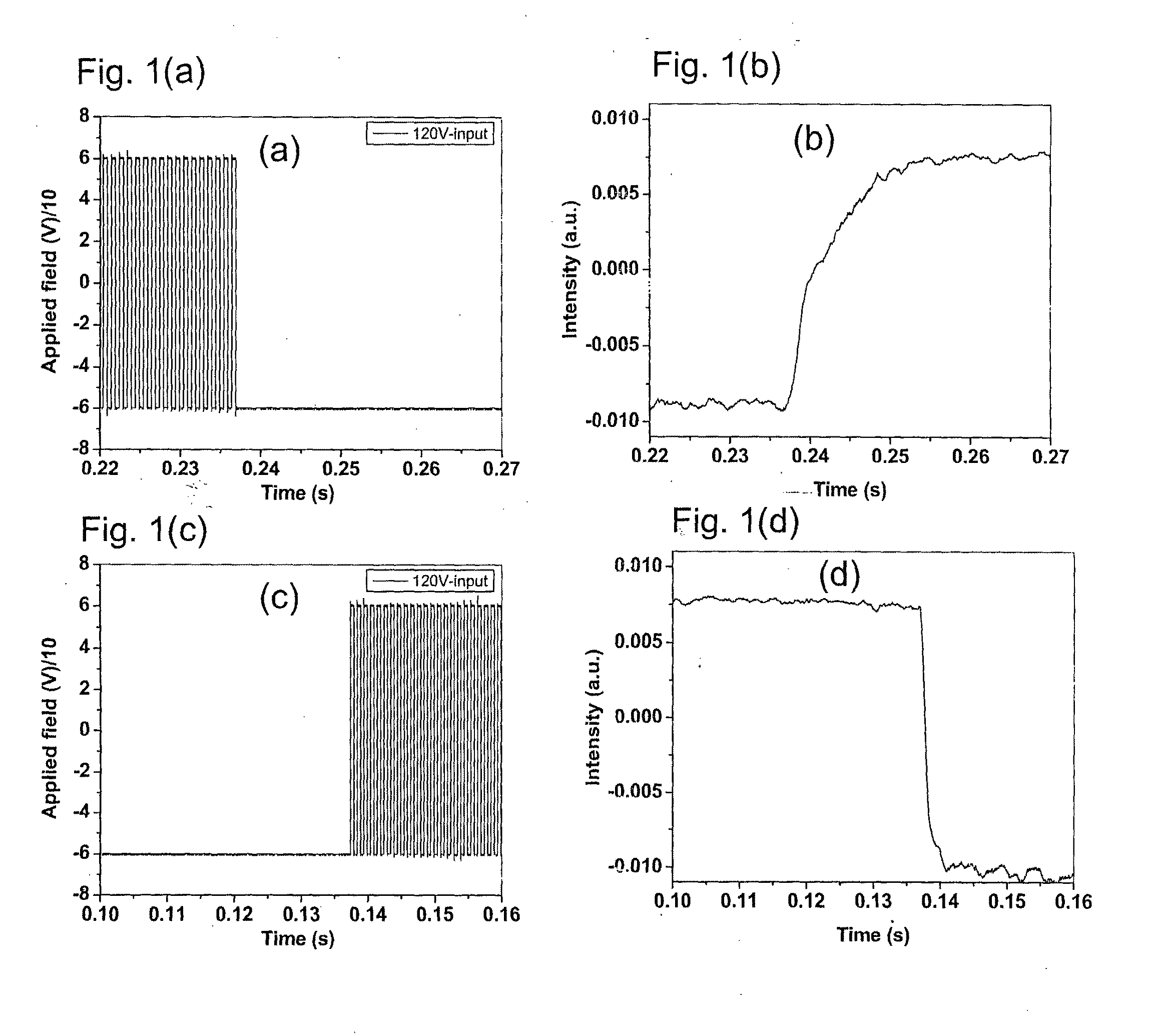Stimuli responsive liquid crystal-polymer composite fibers
a technology of liquid crystal and polymer, which is applied in the manufacture of optoelectronic composite materials, instruments, non-linear optics, etc., can solve the problems of negative impact on textile physical characteristics, such as full flexibility and breathability
- Summary
- Abstract
- Description
- Claims
- Application Information
AI Technical Summary
Benefits of technology
Problems solved by technology
Method used
Image
Examples
example 1
[0045]Electrospinning of PLA / 5CB
[0046]The electrospun composite fibers of PLA / 5CB were prepared as follows. First, PLA and 5CB of 42 / 58 weight percent were mixed together, and chloroform / acetone solvent (3:1 volume ratio) was added later. The PLA / 5CB / solvent mixture was stirred on a heating plate (Fisher Model 210T) for a day at room temperature. The concentration of PLA in chloroform / acetone solvent was 7.3 wt % for the samples. Next the polymer solution was drawn into the syringe and injected with a metal needle using a syringe pump. Both pure PLA and PLA / 5CB fibers were electrospun with a metallic needle of 24 gauge (0.41 mm in diameter). The electric potential difference (10 kV−22 kV), the collection distance (6 cm−16 cm), and the feeding rate (0.1 mL / h−1 mL / h) were varied to modify the morphology of the composite fibers.
[0047]Materials and Methods
[0048]For electro-optical characterization, 5CB / PLA (58 / 42 wt %) fibers were elctrospun onto an indium-tin-oxide (ITO) coated glass (...
example 2
[0058]Electrospinning of PLA / Cholesteric Liquid Crystal Mixture
[0059]The electrospun composite fibers of PLA / cholesteric liquid crystal were prepared as follows. First, cholesteric liquid crystal mixture was prepared from E7 / CB15 / CE2 with a weight ratio of 59 / 29 / 12. Next, PLA and cholesteric liquid crystal was mixed together (45 to 55% by weight ratio), and chloroform / acetone solvent (3:1 volume ratio) was added later. The PLA / cholesteric liquid crystal-solvent mixture was stirred on a heating plate (Fisher Model 210T) for a day at room temperature. The concentration of PLA in chloroform / acetone solvent was 7.3 wt % for the samples. Next the polymer solution was drawn into the syringe and injected with a metal needle using a syringe pump. Both pure PLA and PLA / cholesteric LC fibers were electrospun with a metallic needle of 24 gauge (0.41 mm in diameter). The electric potential difference (10 kV−22 kV), the collection distance (6 cm−16 cm), and the feeding rate (0.1 mL / h−1 mL / h) wer...
example 3
[0060]Electrospinning of PMMA / 5CB
[0061]The electrospun composite fibers of PMMA / 5CB were prepared as follows. First, PMMA and 5CB of 50 / 50 were mixed and DMF solvent was added later. The PMMA / 5CB / DMF mixture was stirred on a heating plate (Fisher Model 210T) for a day at room temperature. The concentration of PMMA was 25% by weight in DMF. Next the polymer solution was drawn into the syringe and injected with a metal needle using a syringe pump. PMMA / 5CB fibers were electrospun with a metallic needle of 24 gauge (0.41 mm in diameter). The electric potential difference (10 kV−22 kV), the collection distance (6 cm−16 cm), and the feeding rate (0.1 mL / h−1 mL / h) were varied to modify the morphology of the composite fibers.
[0062]Nematic phase of liquid crystals is one of the mesophases of liquid crystals without any positional order. The rod-like shaped nematic liquid crystals, such as 5CB, form an orientationally ordered uniaxial phase with a unit director n, representing the average di...
PUM
| Property | Measurement | Unit |
|---|---|---|
| collection distance | aaaaa | aaaaa |
| voltage | aaaaa | aaaaa |
| collection distance | aaaaa | aaaaa |
Abstract
Description
Claims
Application Information
 Login to View More
Login to View More - R&D
- Intellectual Property
- Life Sciences
- Materials
- Tech Scout
- Unparalleled Data Quality
- Higher Quality Content
- 60% Fewer Hallucinations
Browse by: Latest US Patents, China's latest patents, Technical Efficacy Thesaurus, Application Domain, Technology Topic, Popular Technical Reports.
© 2025 PatSnap. All rights reserved.Legal|Privacy policy|Modern Slavery Act Transparency Statement|Sitemap|About US| Contact US: help@patsnap.com



